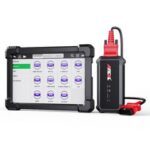You’re venturing into the exciting, and potentially complex, world of vehicle communication networks. Modifying your vehicle’s systems carries inherent risks, and improper handling of the CAN bus could lead to unintended consequences or damage. Therefore, proceed with extreme caution and understand that the following information is provided without warranty or guarantee. You assume full responsibility for any outcomes. Always begin experimentation with your vehicle safely parked. If any part of these instructions or the code is unclear to you, it’s a strong indication that this project might not be suitable for your current skill level. Consider purchasing a pre-made Bluetooth OBD-II dongle as a safer alternative. With that said, let’s explore the possibilities.
Does the term CAN bus ring a bell? Perhaps it reminds you of LAN (Ethernet) or WLAN (WiFi) networks in your home. That’s because they share a fundamental concept: networking. CAN, short for Controller Area Network, is the digital nervous system of your modern car. Instead of a spaghetti of wires running from the engine computer to every sensor, light, and actuator, your vehicle uses this network to digitally manage and control all these components.
The CAN bus operates on a differential communication protocol, remarkably efficient as it only requires two wires to function. Unlike traditional serial communication with separate transmit (Tx) and receive (Rx) lines, CAN bus facilitates communication between multiple devices over these two wires. Typically implemented as a twisted pair cable to minimize interference, the CAN bus network is accessible through your car’s OBD-II port. While a deep dive into the intricacies of the CAN protocol isn’t mandatory for this project, a working understanding is crucial for writing or modifying the Arduino code that we’ll be using.
Before moving forward, verify that your vehicle utilizes a CAN bus system. Virtually every car manufactured today is equipped with an OBD-II port. These ports are standardized with the same physical connector located beneath your dashboard. However, it’s important to note that communication protocols can vary significantly depending on the car manufacturer. Vehicles sold in the United States post-2008 generally adhere to the ISO 15765 CAN bus standard, which is ideal for this project. Confirm your vehicle’s CAN bus compatibility. Remember that every vehicle is unique. You will likely encounter variations in CAN bus speeds, specific OBD-II codes required to request data, and individual quirks that you’ll need to address during implementation.
